Halfway through the latest volume of his colossal biography of Stalin, Waiting for Hitler: 1928-41, the American historian Stephen Kotkin in passing gave a pen-portrait of Mussolini, whose finance minister knew about a shortage of artillery before Mussolini – who was also his own war minister – knew. This was a moment of truth into the ‘inattention, inaccessibility and incompetence’ of the fascist dictator.
Something similar has befallen Gatwick Airport, Sussex Police and the UK generally as one of the country’s main airports was paralysed for more than 24 hours thanks to a drone or drones. Presumably one or a handful of people with kit costing perhaps hundreds of pounds were able to ruin the days and holidays of tens of thousands of people, and cause inestimable reputational damage to the UK.
Who did it? Does the Grinch have an alibi? Presumably it wasn’t anyone demonstrating what drones can do. Who would want to show up the police and politicians as powerless, despite the spending on CCTV, fencing and surveillance, and all the trappings of power – Sussex Police could not resist using a photo of two armed police with their release about December 20. Blind to the fact that shooting at a drone at very best would bring it down and perhaps cause harm, and shooting and missing would mean bullets going who knows where around some critical national infrastructure, not to mention people.
Likewise the Government pressed what buttons it could; calling on the Army, as in Tony Blair days, when armoured cars were deployed at Heathrow. In the House of Commons, the Leader of the House Andrea Leadsom called the affair ‘absolutely unacceptable‘, the standard condemnation for anything that the authorities know is wrong but cannot do anything to remedy. She pointed out, as did Prime Minister Theresa May, that it’s a crime to fly a drone illegally with a potential prison sentence (if only the culprit can be caught) and that drone use is in need of regulation (‘consultation is under way’).
Just as with cyber, the possible ‘threat actors’, the kinds of people who would cause such a disruption are the loners; organised groups, activists; and nation states. If an anti-capitalist or environmentalist group, why have they been so modest and not said anything.
Some on social media queried the Civil Aviation Authority’s prompt ruling that the shutting of Gatwick was due to ‘extraordinary circumstance‘ and airlines would not have to compensate passengers. Just as acts of terror seldom go ahead without the attackers making a physical reconnaissance of the site beforehand, at least once, so it is likely that the drone misuser did not turn up suddenly. How extraordinary is a drone ‘disruption’ when drones have their own section on the CAA website and the CAA has brought out ‘Dronesafe’, its pious guidance to proper use of drones; when power stations, ports and airports have been buzzed for some years, and had reported near-misses; and any airport with its eyes open has drones on its risk register.
Sussex Police’s view that the incident is not ‘terrorism-related’ is also questionable. How many people flying into and out of Gatwick will feel fear now – the definition of terror? From the point of view of input versus output, the enormous losses due to the Gatwick closure – reputational, lost income, cost of policing and patrolling, bussing of passengers to other airports, inconvenience, stress of people wondering if their holidays will go ahead – compared with the minimal time and effort to put up the drone, are on a par with 9-11, when a handful of terrorists killed 3000 and did trillions of damage; let alone the baleful resulting history.
Just as 9-11 was chillingly simple – use a commercial airliner as a weapon – so was the Gatwick drone attack: a piece of kit for sale on any high street able to paralyse an airport. Whereas aviation security evolved and another 9-11 did not occur, although there is no way of saying whether a repeat would have happened but for measures, the authorities appear without palatable options to prevent a repeat, without running the risk of sending aircraft into the air with the financial and reputational reckoning if a drone then brings an aeroplane down. Either a crack-down on drones (and how to enforce that?) or carry on and cross fingers. Because don’t expect anything soon to get around the dilemma that, once a drone is airborne near an airfield (or anywhere causing a safety hazard – that is, any built-up part of any town or city), it’s as dangerous to bring it down violently as it is to let it fly around or crash; or indeed deliver a malicious pay-load. As a sign of how everyone – academia, politicians, practitioners wanting the tools to keep drones at bay – is still flailing around for answers, Radio 4’s Inside Science show on December 20 took seriously an Imperial College idea of eagles trained to take down drones.
An idea scoffed at in the January 2018 print issue of Professional Security magazine. Has anyone thought for a minute whether a bird of prey would want to go anywhere near a drone with its whirling blades? Let alone in the dark possibly? And how would you keep up a shift pattern of birds to cover an entire perimeter? At a noisy working airport where birds are among the hazards?









